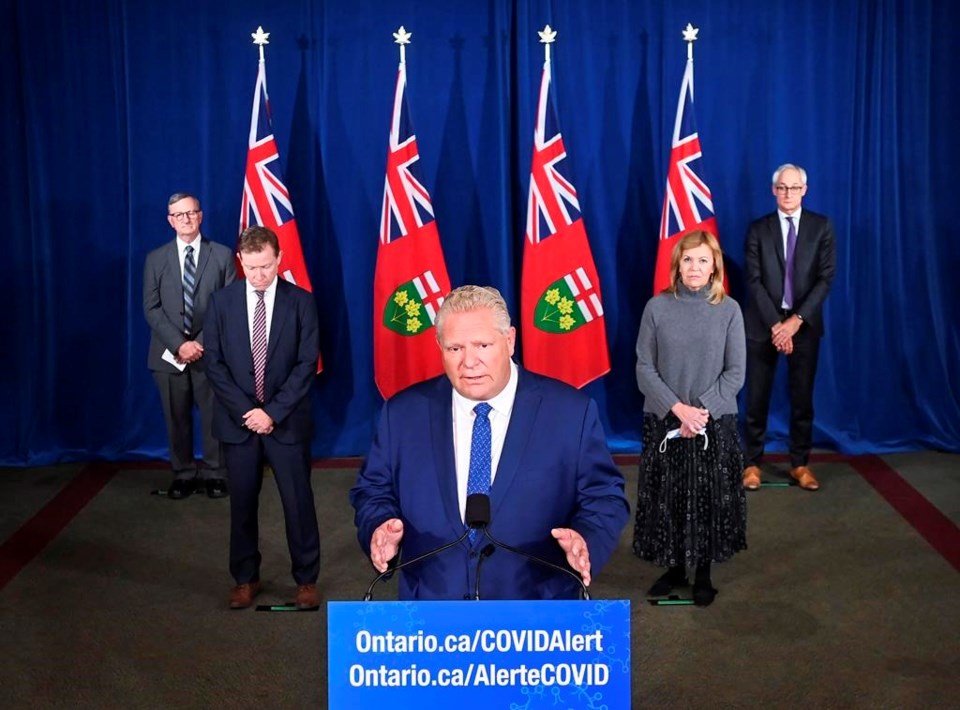TORONTO — Ontario announced tighter COVID-19 restrictions Friday amid mounting criticism that the government was ill-prepared for a second wave of the pandemic, which has seen crippling lines at assessment centres, a ballooning testing backlog, and a surge in new cases.
But public health officials in Toronto — the hardest-hit city in Ontario — said the measures did not go far enough in dealing with a provincial caseload that could reach 1,000 new daily infections by mid-October, according to the latest modelling.
The province said it would make COVID-19 testing available by appointment only, require masks in all public indoor spaces, and tighten restrictions on businesses in virus hot spots.
"We have made some tough but necessary decisions always based on the best medical advice and scientific evidence available," said Premier Doug Ford, as he defended his government's preparedness plan.
The government also said it would put a "pause" on 10-person social bubbles, and urged people in the province to only have close contact with those who live in the same household. Those who live alone can consider having close contact with another household.
"All we're saying is just be careful," Ford said. "Just keep your circles tight."
Ontario reported a record 732 cases Friday and a backlog of 90,513 tests.
Ford said the shift to scheduled appointments at the province's 155 assessment centres will help them "winterize" and further address hours' long lineups.
"It will make sure folks don't have to wait outside for hours," Ford said. "It will help us ensure necessary screening takes place to ensure those that need a test can get a test."
For weeks, the majority of new cases have been reported in Toronto, neighbouring Peel Region and Ottawa, and Ford said immediate action was required in those areas.
He said restaurants, bars, banquet halls and gyms in those regions would all face restrictions on their operations.
No more than 100 customers will be allowed in restaurants and no more than six people will be permitted at a table. Restaurants will also be required to collect contact information from all patrons to bolster contact tracing.
Toronto's medical officer of health called on the province to do more, suggesting it ban indoor restaurant and bar service for four weeks — two incubation periods for the virus — suspend indoor fitness classes and sports, and ask people to only leave their homes for essential trips.
Dr. Eileen de Villa said while she has some authority to make such changes under existing public health regulations, she received legal advice that it would be "unprecedented" for a local medical officer of health to enact such broad changes.
"These numbers won't reverse on their own, they won't reverse themselves. They will only increase without action," de Villa said in a news conference Friday.
"This is why I am asking the province for support to do more. Quick action is needed now."
Both the Ontario Hospital Association and the Registered Nurses' Association of Ontario have called for tougher restrictions on hot spot regions.
Earlier this week the OHA called for Toronto, Peel and Ottawa to be shifted back into Stage Two of the province's reopening plan, a move that would close indoor dining areas of bars and restaurants, gyms and movie theatres.
The OHA warned that hospital capacity was in serious jeopardy because of the increasing case counts.
On Friday, the RNAO also said the province needed to shut down bars and not allow inside table service at restaurants. It should also close gyms and churches, the group said.
The organization's CEO, Doris Grinspun, described the province's announcement as "too little, too late," noting most municipalities had already implemented mandatory masking policies.
"We absolutely need to take more serious measures — if we don't, if we don't take them now, what will happen is that we will have a complete lockdown in a matter of a very short time," she said.
Colin Furness, an infection control epidemiologist at the University of Toronto, said the new measures will not go far enough to cut rising case rates.
Targeted testing is needed in places where transmission is occurring, and the government should close bars and restaurants completely, he said.
"We're falling further behind every day," Furness said. "We're not managing this pandemic at all. We're reacting to it."
Meanwhile, the medical director of Toronto Western Hospital's COVID assessment centre said the changes to social bubbles need to be clearly communicated.
"The lack of clarity just makes people throw their hands up," said Dr. Camille Lemieux. "I think it really loses traction with people who are just completely exhausted with all of this."
NDP Leader Andrea Horwath said the government is putting Ontario at risk with "half measures and contradictory rules."
"(Doug Ford is) applying superficial Band-Aids to deep gashes," she said in a statement. "He never had a plan to stop the second wave from getting out of control, and so it has."
This report by The Canadian Press was first published Oct. 2, 2020.
Shawn Jeffords and Paola Loriggio, The Canadian Press

